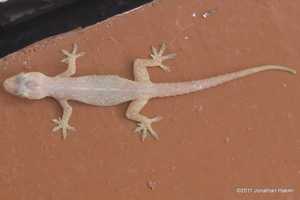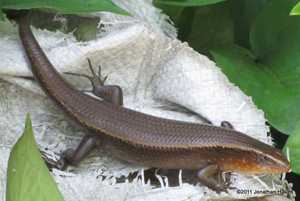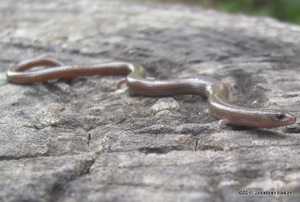Lizards are the most common reptiles in Bangkok, and are a big part of natural pest control. There are house geckos eating flies and mosquitoes in our rooms, Tokays munching on mice and cockroaches on the roofs, skinks and garden lizards hunting down garden pests, and monitors cleaning up carrion. Bangkok would be a dirtier and more diseased place without its lizard populations.
Geckos – soft lizards on the walls
Geckos have soft skin, large eyes, and famously run up and down the city’s walls. Geckos are usually seen at night, but can be found during the day inside darker areas. The following geckos are found in Bangkok:






Skinks – sleek lizards on the ground
Skinks are the long smooth lizards that are seen on the ground or hiding under objects. The following skinks are found in Bangkok:





Lacertas – slender lizards in the grass
Lacertas are a family of quick, long-tailed lizards with small scales that are usually spotted out in the open during the day. The Bangkok area has one species of lacerta.

Agamas – spiny lizards in the bushes
Agamas have rough scales and often have a small crest going down their neck. They are active during the day and are often seen on trees or other vegetation. These agamas are found in Bangkok:


Monitors – big lizards in the water
Monitors are the giants of the lizard family. You can recognize them immediately by their characteristic heads and large size. There is only one species of monitor found in Bangkok:

I live on the outskirts of Bangkok (Samut Prakan) and very often here a small animal, but never see one. I am not sure of the spelling but sounds like tuckare. Maybe they get the name from the sound of their call which sounds like their name. Would you have a photo of this animal?
Yes, I believe you are referring to the “Tokay Gecko”. Look for the blue-and-red gecko in the photos above.
Hi I used to live in the NE in 1982 a Tokay Geko lived in a space in a wall just underneath the rafters. I had always assumed it was a lizard. Thanks for your blog.
Leo
Yesterday i went out at night with the flashlight searching for reptiles in a backyard of my condo, and found an Oriental Garden Lizard sleeping on a branch of a bush. It’s eyes wasn’t closed, but it let me come really close to make a shot.
Please give me information on Thailand Reeves’ Butterfly Lizard.
I have a video of one I didn’t see in your list, at least which I recognized. Email me back if you would like it. Little guy has an extremely long tail, and almost appeared to walk on his hind legs. Didn’t get to video him in motion, regrettably.
Thks for this. It helped my curiosity with the skink, agama, gecko I find in my area in the hills north east of saraburi province. Also i.d.’d 2 kinds of wolf snakes here. Seen and took pics of water monitor lizard in Samut Prakarn.
good info thank u
I live in malaysia but i can also found all the species of lizards here in malaysia do they travel?
Yes, all of these species are fairly wide-ranging and nearly all occur in Malaysia as well as Thailand. When I update the species accounts later this year or next I will be including the ranges of every species as well as many more Malaysian lizards.
I’m staying on Koh Chang and this morning I observed a young water monitor, about 24 inches long, stalk and catch a slightly smaller agama. Is it common for small monitors to hunt and kill other lizards? I was surprised, since the agama was about half the size of the young monitor.
Great observation! I haven’t seen it myself before but no, it’s not too surprising. The younger they are the more active they are going to be in chasing down prey.
Cool, thanks for the reply!
I was in Kao Yai national park one month ago. I saw a lizard with an orange flap under its neck coming out from time to time. What kind of lizard is it and what is the meaning of this behavior?
What you saw was probably a species of Flying Dragon. They are small slender lizards that usually look quite normal but can spread out flaps of skin to glide from tree to tree. The males have a flap of skin on their throat called a “dewlap”. It is used as a signal – they flash it aggressively in order to warn other males to stay away from their territory, but they also use it to try to attract females to them. If you only saw one lizard then it was probably using the dewlap towards you in a territorial manner.
Hi there.
I’ve got some questions and experiences with the Flat-tailed House Geckos. I live in Bkk (4 years same apartment) and I spend 70% of my time outside on the balcony (4th floor). So these 2 Geckos became like my family here to the point where they’re actually eating with me… believe it or not… I got photos and videos.
Now recently the female hatched 2 eggs (I also have close up video footage where you can actually see the eggs inside her). The babies are now probably about a month and a half old and quite active in the bathroom, but not coming outside yet. What saddens me is I don’t see the parents around anymore… Not the male or female…. Not inside or outside.
Do they dessert their young? Did they leave completely? Will they return? They don’t even come to eat anymore, and they were only outside… never inside. Only the one baby is inside.
It would be interesting to know if they’ll ever return or what… I miss my little “kids”…. Or will the babies take over from here and now onwds?
Something that might have been an influence on them leaving, might also be some pigeons that’s been trying to nest here on top of the aircon machine outside. As much as I want to, I can’t chase them either and now even the pigeons are coming inside, even if I’m in there or not, they just took over… Lol.
That’s a fascinating observation. Flat-tailed Geckos don’t care for their young after they’re born, but they wouldn’t just leave the area without a reason. Your guess could be right that the pigeons have disturbed them. Or it’s possible that some other change caused them to leave. Or, sadly, they may have died or been eaten by something. That is the way of life (most small lizards only live a few years). But, as you note, hopefully the baby can take over now.